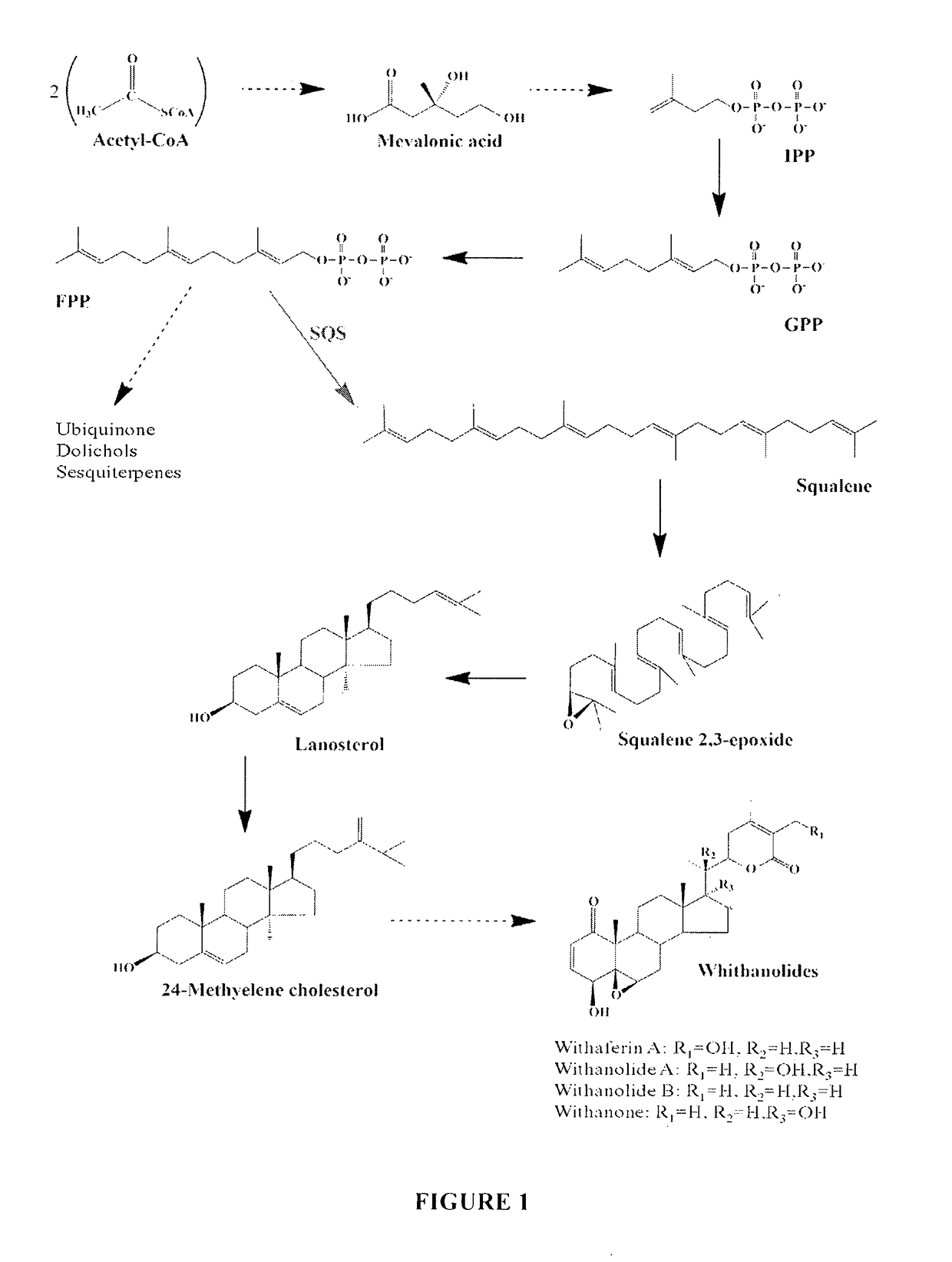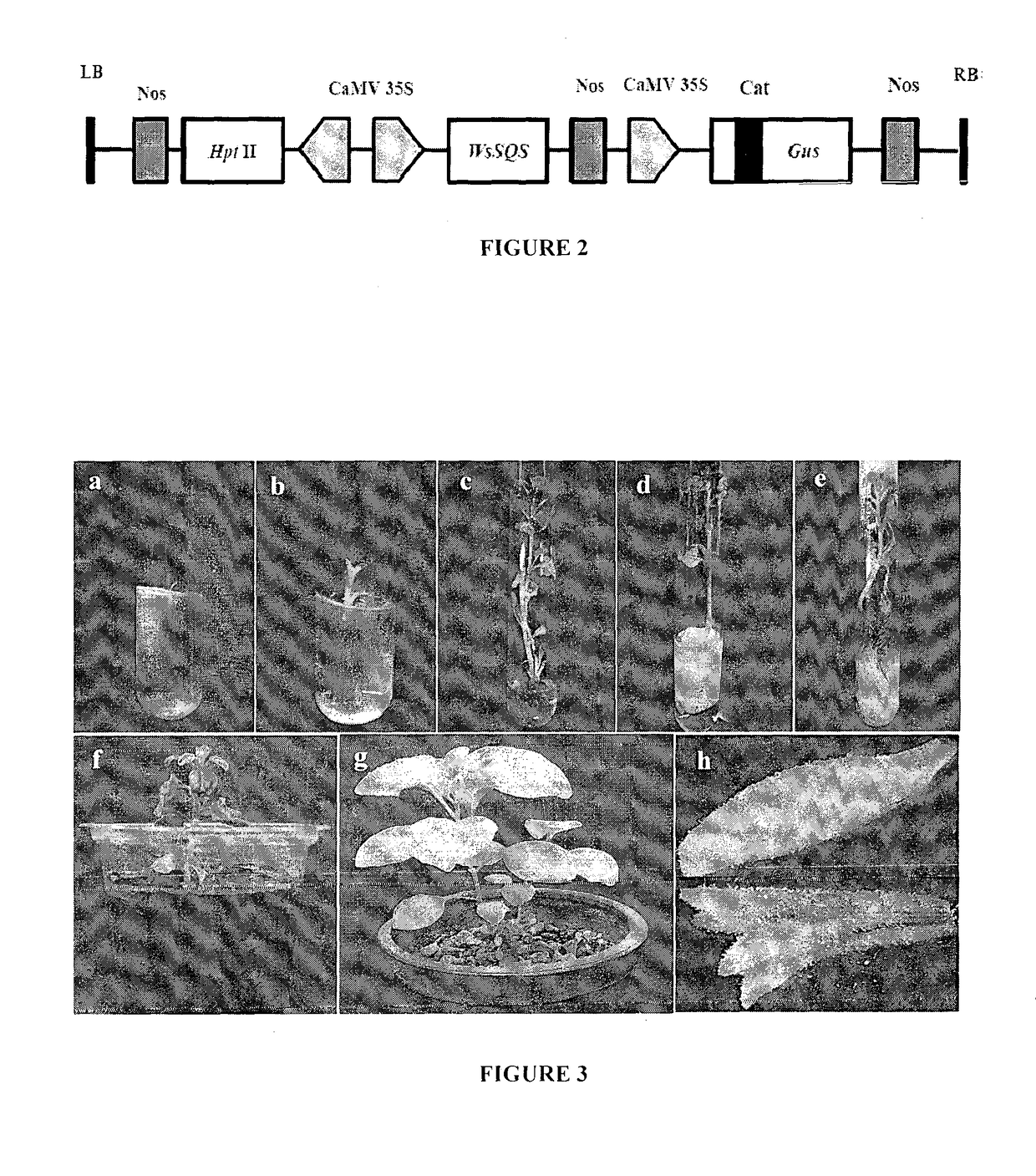Process for transformation in withania somnifera plants to increase secondary metabolite content
a technology of withania somnifera and genetic transformation, which is applied in the field of genetic transformation of withania somnifera to produce hardened plants with increased secondary metabolite content, can solve the problems of inability to achieve the minimum concentration of withanolides, low yield, and process inability to produce secondary metabolites, and achieves the effect of enhancing secondary metabolite conten
- Summary
- Abstract
- Description
- Claims
- Application Information
AI Technical Summary
Benefits of technology
Problems solved by technology
Method used
Image
Examples
example 1
Plant Material and Propagation
[0077]Seeds of W. somnifera were procured from Vindhya herbals, Bhopal, MP, India. Seeds were surface sterilized with sterile distilled water and then rinsed with 1% (v / v) teepol for 1 min followed by sterile distilled water washings in laminar air flow cabinet. Seeds were then treated with 0.1% (w / v) mercuric chloride (HgCl2) for 5 min, washed thoroughly with sterile distilled water to remove traces of HgCl2. Seeds were inoculated on germination medium (half strength MS medium containing 3% (w / v) sucrose and solidified with 0.3% Phytagel) and incubated in dark for 15 days to germinate. Germinated seeds were transferred to liquid half strength MS medium for further seedling development. Seedlings were cut into apical and nodal segments of about 1 cm length containing a single node along with a small portion of petiole and micropropagated by inoculating into the proliferation medium (MS medium supplemented with 0.1 mg l−1 kinetin, 0.2 mg l−1 6-BAP) for s...
example 2
Vector Construction
[0078]Previously cloned full length WsSQS (GenBank GU732820) with an open reading frame of 1242 bp (SEQ ID NO. 1) was amplified using primers having sites for restriction enzymes KpnI and SacI. The resulting fragment was positioned between cauliflower mosaic virus (CaMV) 35S and a nopaline synthase (Nos) terminator in modified pCAMBIA 1301 vector (Omer et al., 2013) which had been already digested with the same enzymes. The correct orientation within the vector was confirmed by DNA sequencing and the construct was transformed into A. tumefaciens GV2260. The T-DNA region of the vector was constituted by gus (β-Glucuronidase) reporter gene and a selectable marker hpt II (hygromycin phosphotransferase) gene imparting resistance to hygromycin B under the control of the constitutive CaMV 35S promoter (FIG. 2).
example 3
Genetic Transformation of W. somnifera
[0079]Genetic transformation in W. somnifera was achieved by A. tumefaciens GV2260 carrying WsSQS. A. tumefaciens was grown in yeast extract minimal medium containing 50 mg l−1 rifampicin and 50 mg l−1 kanamycin, harvested by centrifugation and the bacterial pellet was resuspended in MS medium to obtain appropriate bacterial cell density for infection. Two days pre-cultured explants were immersed in freshly prepared bacterial suspension for 15 min and co-cultivated with A. tumefaciens for 48 h in dark and then transferred to a proliferation medium containing 250 mg l−1 cefotaxime for ten days. Expression of the inserted gene in transformed tissues was confirmed by Gus assay to detect the β-Glucuronidase activity (Jefferson et al., 1987) and visualizing it under a stereoscope (Leica MZ 125, Switzerland). Explants exhibiting shoot development were then transferred to selection medium (proliferation medium containing 10 mg l−1 hygromycin B). Hygro...
PUM
| Property | Measurement | Unit |
|---|---|---|
| concentration | aaaaa | aaaaa |
| length | aaaaa | aaaaa |
| density | aaaaa | aaaaa |
Abstract
Description
Claims
Application Information
 Login to View More
Login to View More - R&D
- Intellectual Property
- Life Sciences
- Materials
- Tech Scout
- Unparalleled Data Quality
- Higher Quality Content
- 60% Fewer Hallucinations
Browse by: Latest US Patents, China's latest patents, Technical Efficacy Thesaurus, Application Domain, Technology Topic, Popular Technical Reports.
© 2025 PatSnap. All rights reserved.Legal|Privacy policy|Modern Slavery Act Transparency Statement|Sitemap|About US| Contact US: help@patsnap.com



